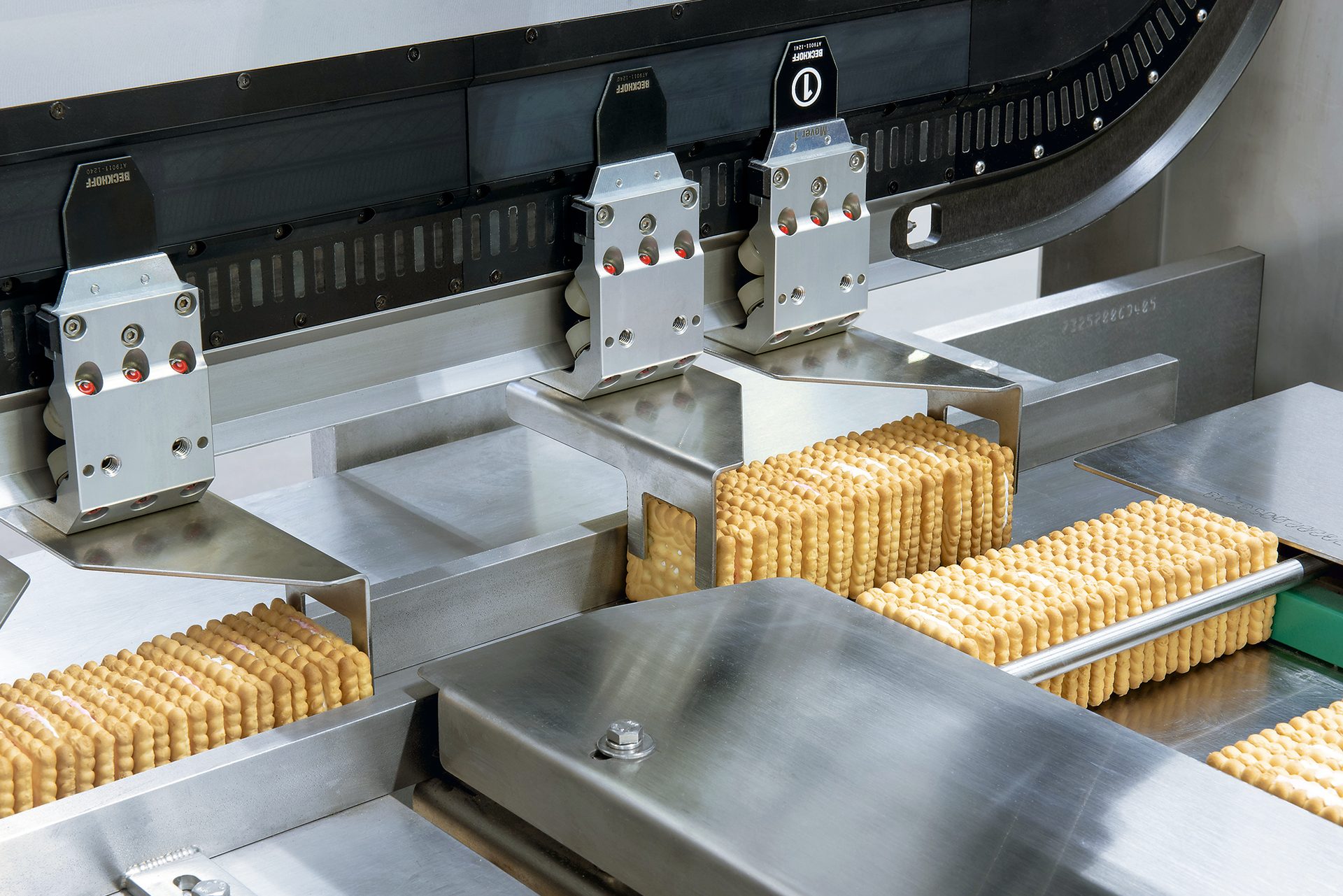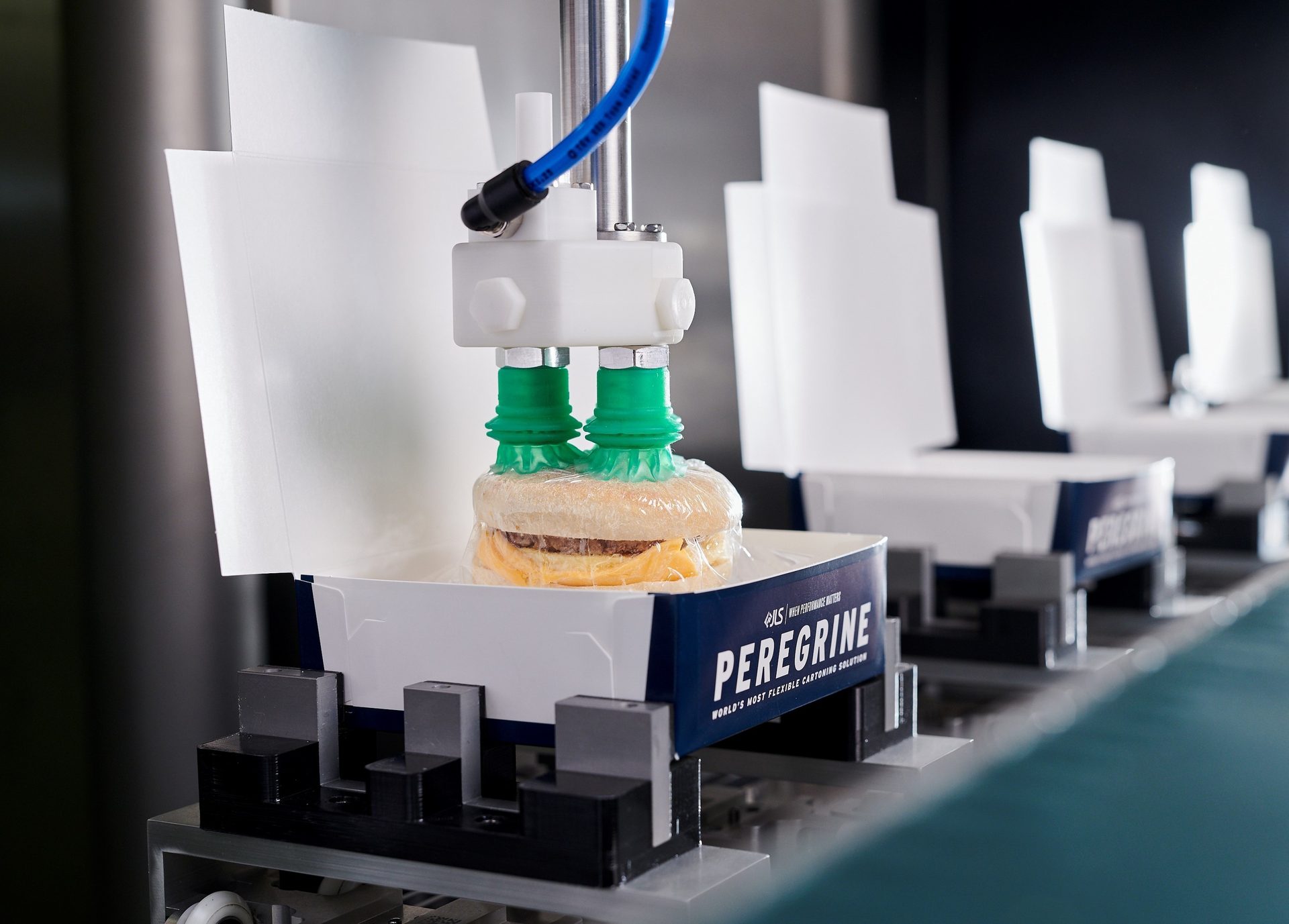The use of automation in snack food and wholesale bakery facilities has been increasing steadily for years, but it’s taken a major leap forward during the pandemic with the resulting need for social distancing in the early months, followed by difficulties hiring qualified personnel during the past year and a half.
Automation
report
The BOTTOM LINE
- Flexible packaging solutions
- Helpful robots, cobots
- AI options
Automation acceleration
Automation is nothing new for the industry, but the pandemic has revved it up further.
Ed Finkel, Contributing Writer
“Manual work will be replaced more and more by automation,” predicts Heiko Soehner, technical account manager, bakery and confectionery for Siemens, Nuremberg, Germany. “Most of the bakery lines are automated, especially in large factories. This continues more and more in small and medium-sized companies. There is no way back. It’s looking like a one-way road.”
Craig Souser, president and CEO of JLS Automation, York, PA, has sensed a bit of easing off in recent months due to inflationary concerns and other economic pressures. But even that has “not made people stop or kill projects, but slow some things down,” he says. “But automation is still the answer for so many people in terms of trying to solve the labor shortage. Unfortunately, none of it is fast enough, far-reaching enough, to be a short-term fix. But it’s clearly the long-term strategy; it has been since pre-COVID, and it’s only accelerated.”
What’s new
Several new automation developments have been on the radar screen of Rick Forsgren, packaging industry business development manager at Beckhoff Automation LLC, Savage, MN. For one thing, there’s been increased demand for flexible packaging solutions that can change over rapidly between package type and size, and even material. “Because of that increase demand we’ve seen an increased desire from OEMs to work with smart linear track systems,” he says. “It’s being utilized more often as the technology has matured.”
“It has allowed them to take advantage of those technologies to move things in a way that hasn’t always been possible.”
— Rick Forsgren, packaging industry business development manager at Beckhoff Automation LLC

Forsgren also has seen growth in the integration of robotic solutions into the smart linear track systems. “Some customers have developed innovative ways of using those two things together,” he says. “It has allowed them to take advantage of those technologies to move things in a way that hasn’t always been possible.”
Another innovation that’s gained customer interest is magnetically levitated movers, which are individually controlled “pucks” that can be tipped or spun in the X and Y axes and raised and lowered in the Z axis, enabling flexible layouts and movement with no-wear parts, Forsgren says. “You take a sheet of stainless steel, lay it over the motor modules that are the base, and the pucks that fly on it don’t actually touch the surface,” he says. “Some customers have developed creative coverings for the movers, allowing the product to be very easily scooped off the top of the puck without sticking.”
Forsgren also has seen greater interest in cloud connectivity, enabling pulling information off machines, optimizing processes, and better understanding the use of ingredients. “You can get a better idea of usage and track ingredients closely,” he says. “You can track output from the extruder to make sure there isn’t giveaway.”

Courtesy of Beckhoff Automation
In the robotics-centric world of JLS Automation, one innovation that’s become close to mainstream are cobots, a relatively inexpensive, easy-to-use technology that can perform a variety of tasks, including downstream processes like secondary packages or perhaps palletizing, Souser says. “They are good for the industry. It does get people more comfortable with robotics,” he says.
Closer to his own company’s offerings, Souser sees significant advances in the area of three-dimensional vision capabilities, employing deep-learning algorithms to take vision-sensing analyses to a much larger level. “That vision system can learn, without having to teach it everything,” he says. “We’re implementing machine learning with some customers on trial. It’s going very well, and we’re looking to implement it as a standard offering.”
Soehner believes the experience of the snack or bakery operator will become increasingly centered around automation. “Today you have people in a bakery tasting and looking for consistency; quality people who take a piece of cookie into the lab and check it,” he says. “Based on his experience, he will add one more kilo or pound of flour or water. But due to the lack of experienced people or willing people, and also to improve the quality of the product, it should be automated.”

Courtesy of JLS Automation
Artificial intelligence and machine learning will be central to this shift, Soehner says. “It will be IT meets OT, merging more and more together,” he says. “You do not talk only about PLCs, and sensors, and drives; you’re talking about the IT direction. That means you must be able to update your system automatically, as we see more and more cyberattacks. In nearly all regions of the world, the bakery industry is critical infrastructure; you need to take care that your systems are cyber-safe.”
Where automation makes sense
Adding automation makes the most sense in areas with highly repetitive manual motion, Forsgren says. “That’s where the bang for your buck comes from,” he says. “The labor shortage is still driving the need to move toward more and more automation. It isn’t even that people wouldn’t hire people to do the manual work; there aren’t people to be hired. Those kinds of operations, we’re seeing people make investments, because they have to. It’s virtually all CPGs.”
Other areas that lend themselves to automation include those where a facility is seeing a high number of repetitive stress injuries, or where too much product is being put into the package based on the weight specification, or where you need to add capacity or shorten changeover time, Forsgren says. “Every step that goes into a changeover can be very time-consuming, tooling and things like that,” he says. “We do see OEMs making a big investment in automating machines.… Where is the slowest part of the line? Work there first, to keep it from bottlenecking.”
Souser segments snack and bakery into three buckets. High-velocity, high-run products like breads and rolls that might go for days without a changeover are ripe for automation, and probably traditional, conventional automation as opposed to anything robotics-related, he says. In the middle are snack-cake items, cookies, and specialty breads that have shorter but still significant runs. “Robotics are a good solution there because they are more flexible than a hard automation solution, which would be difficult to change over quickly,” he says. “But you still need to run that for a certain number of hours to make it [financially] viable.”
Shorter runs probably still don’t make sense to automate because they bring such high flexibility needs that they require a manual process, Souser says. Those became less common during the height of the pandemic “because bakers had to determine that there are SKUs that I can’t afford to produce,” he says. “I have to deliver on higher runners. That said, marketing departments still do their thing and come up with new ideas so people want to try new products. Some don’t make sense the tool up with automation.”
Similarly, Soehner sees two categories—a mass production, 24/7 product like runs that “definitely make sense to automate” because they require no changeover; and a smaller-batch product that still needs some automation to be able to optimize changeover times. “This is not directly related automation of the equipment on the shop floor,” he says. “It’s related to having the right ingredient, at the right time, with the right equipment.”
How to add automation incrementally
Automation providers recommend a phased approach for those who haven’t gone too far down the road, especially those who don’t have vast resources.
“Spread your risk out; keep yourself from getting overwhelmed,” Forsgren says. “Me, being a packaging guy, that can be a good place to start for people. It’s low-hanging fruit. A machine can replace two or three laborers. But it’s not a panacea. You’re going to need people—not as many of them—but different people, a technical staff who knows how to work controls and robots and mechanical systems. There is a challenge to finding those people as well.”
Starting with packaging, especially at the end of line, removes the possibility you hit a lack of capacity downstream that can cause a stoppage. “If you think about the flow of a line, starting at the end and working your way back is a good way to phase that in,” he says. Other pieces to automate could include “actionable items for analysis, and optimizing processes, connectivity and sensorizing of processes for better traceability, and better measurement to understand what issues can be fixed—potential recalls and things like that.”
Souser suggests a “crawl, walk, run mindset. Get people comfortable knowing that the robot is not from another planet, it’s not something that’s impossible to support, and then take the bigger step, where the real savings are. Go upstream on the primary side: that’s where the labor is and where the big payback can come from. It’s daunting to say [all at once], ‘We’re going to put 20 robots in your facility, and don’t worry, you’ll be fine.’”
There’s not a “black-and-white, one-two-three” obvious path for snack and bakery facilities to take in infusing automation, says Soehner, who suggests honing in on where bottlenecks in production exist. “Does it have a positive impact if you modernize the oven? Does it make sense to add a mixer?’ he says. “It could be simulated, and that could help you focus on that right investment. A small step could be bringing data together in a consistent way that the IT system can use for further analysis. … On the other hand, when you have challenges regarding changeover time, that’s usually a bigger project. It’s hard to do that in small steps.”
Helping customers calculate ROI
Helping customers to calculate their ROI on such investments is something Siemens typically does in tandem with the OEM, Soehner says. “If you get transfer regarding energy consumption, you can have savings of between 5% and 10%,” he says. “These are calculations we can give, [based on] experience, for further projects. For implementing scheduling systems, you need a deeper dive into the full-time equivalents you can save.”
Reduced labor costs tend to be the most obvious ROI, Forsgren says. “That includes things like workers’ comp,” he says. “Then, there’s faster changeovers. What is the downtime associated with your changeover, and what is your throughput value? If you have to shut down for an hour, what does that cost you? Improved uptime is the other side of the coin, and part of that is quality. … If you have a changeover in package size, is there any waste? Are you measuring everything very carefully and very accurately, and how fast can you react to changes?”

Courtesy of Siemens
Reduced footprint is another consideration in calculating automation ROI, Forsgren says. “If you can avoid a major plant expansion, that’s huge savings,” he says. “If you can get better throughput and more product out of the line, a lot of times you can avoid making big investments in plant expansion. One caveat is that some automation can add more space rather than reducing, if you’re having to align machines for certain geographic considerations that need to be made to add automation.”
JLS Automation works with customers to understand what counts and what doesn’t when it comes to ROI. Customers have come back to them to say they’re not allowed to use “soft costs”—like resources expended to hire someone—into their model, Souser says, although “that has changed with COVID. People are saying, ‘We need to factor that in.’ But we do look at things they may not be aware of on the service side, waste reduction being one of them.”
There are also areas where robots are simply faster, Souser says. “People can’t do the velocity a robot can. There are instances where customers have had double-digit increases in throughput,” he says. “Most food producers, if they can pick up 2% or 3%, they’re happy; but if you can get 10% or 12%, that’s huge. At that point, labor [savings] just becomes icing on the cake.”
“Lights-out” automation
The ultimate goal of “lights-out” automation is what snack and bakery producers are working toward, although few see it happening any time soon. Some areas of the supply chain, like warehousing, for example, can be almost completely automated already, although cultural change will need to accompany technological change, Forsgren says.
“It requires zero to very, very little human intervention,” he says. “I expect we’re going to see that kind of progress move into the line in the future. My personal opinion, from having been in this industry for a long time, is that it’s going to take a generation change. I don’t know that the people calling the shots right now are going to have that kind of faith in a completely automated company. … There’s a lot of, ‘if it ain’t broke, don’t fix it’ mentality out there. People are incredibly risk-averse.”
Soehner doubts lights-out snack and bakery facilities will ever happen, although machines are becoming more and more reliable in replacing parts of the work formerly performed by humans. “I don’t think this will be fully replaced,” he says. “There are several elements that are lacking, most notably interoperability. Today’s challenges are how to collect the valuable data and to transfer them from one place to another for detailed analysis. But it’s getting easier to implement it because we, as Siemens, are working a lot on using standards. This facilitates data exchange between devices and disciplines, making production more reliable and efficient.”
Souser doesn’t see “lights out” happening in his lifetime, although certain aspects, such as palletizing, already can be handled that way. “With case packing, it gets more and more difficult,” he says. “Somebody’s got to look at the tape machine. There can be a jam. The robot can do its job perfectly, but there are other things on the line that can’t be left unattended. The further you go up, the more that’s true. … Could we get to the point where you have 10% to 20% of the staff you used to? In some cases, we’re already there. But true, lights-out, unattended? I’m not holding my breath.” SF&WB

